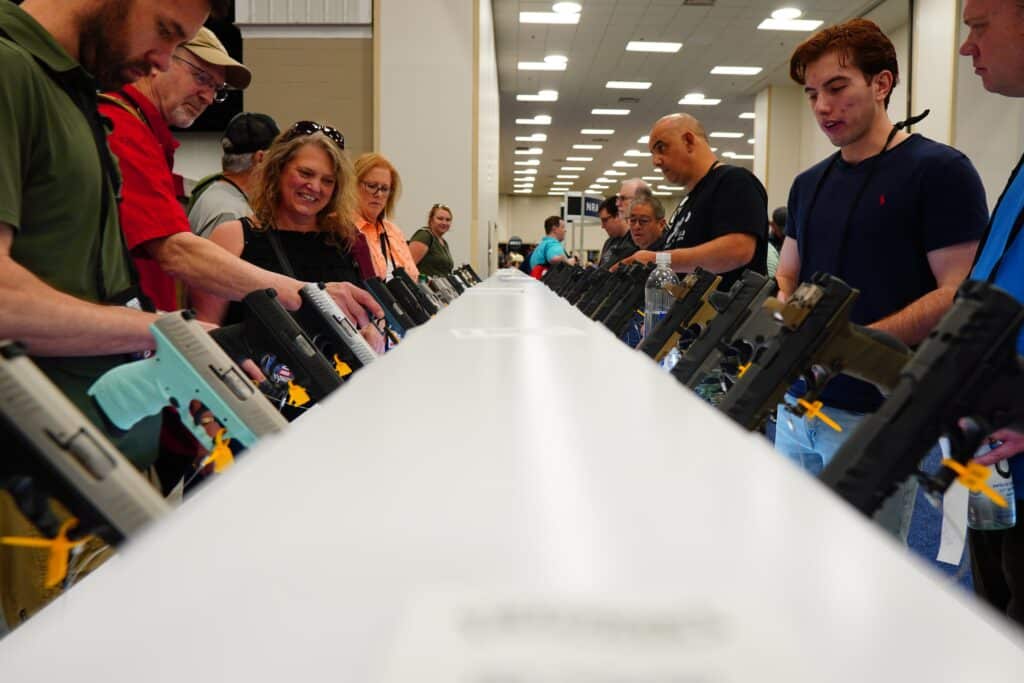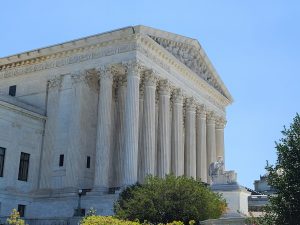After just about a week, the legal theory I’ve found least convincing came right back into the news. This time, though, a federal court has offered a response to it.
I take a deep dive into the fight over whether the “right to keep and bear arms” is limited just to the literal keeping and bearing of them. In other words, does the Second Amendment really offer no protection for the means to acquire or use firearms?
Plus, Contributing Writer Jake Fogleman examines the latest polling showing a massive jump in the number of voters who now have a gun at home.
There’s no podcast this week since I wanted to give the team some well-deserved time off for Thanksgiving. Coincidentally, it also gave me time to head into Lancaster to get some yummy Shoo Fly and Mincemeat pies. Definitely well worth the trip!

Analysis: Federal Court Dismisses ‘One Weird Trick’ Argument in Maryland Pistol Case [Member Exclusive]
By Stephen Gutowski
One of the weakest legal theories in the post-Bruen era has popped up once again in federal court. This time, a federal appeals panel explained why it doesn’t work.
On Tuesday, a three-judge panel of the Fourth Circuit found Maryland’s pistol purchase permit is unconstitutional. The majority ruled that the gun sales restriction failed the test established in New York State Rifle and Pistol Association v. Bruen because it didn’t fit with the tradition of gun regulation dating back to the Founding Era. Therefore, it decided the law violates the Second Amendment.
As part of that decision, the majority exercised what I’ve labeled the “one weird trick that plaintiffs hate” theory of Bruen.
Just a week earlier, a different federal court handed down a decision that exemplified the theory. In Rocky Mountain Gun Owners v. Polis, US District Judge John L. Kane upheld Colorado’s three-day waiting period for gun purchases. He argued that gun sales simply weren’t protected by the Second Amendment at all.
“After examining the language of the Second Amendment using the Supreme Court’s analysis in Heller, I find, for the purposes of Plaintiffs’ Motion, that the plain text does not cover the waiting period required by the Act,” Judge Kane wrote. “This conclusion is bolstered by the fact that the Act is a regulation on the commercial sale of firearms and thus is presumptively permissible.”
He went on to say the “plain text” of the Second Amendment doesn’t cover “the receipt of a paid-for firearm without delay.” He argued the right to “keep and bear arms” doesn’t implicate a right to buy or sell them.
“Still, Plaintiffs attempt to equate the words ‘obtain’ and ‘possess.’ But these terms are not equivalent,” Judge Kane wrote. “To ‘keep,’ under the definitions provided in Heller, meant to retain an object one already possessed. It did not mean to receive a newly paid-for item, and it certainly did not mean to receive that item without delay. Likewise, ‘hav[ing] weapons’ indicates the weapons are already in one’s possession, not that one is receiving them.”
In October of last year, US District Judge George H. Wu employed the same reasoning in denying a preliminary injunction against California’s ban on possessing unserialized homemade guns. In that case, he argued the right to “keep and bear” didn’t cover the right to make or build guns.
“Though it leads with a recognition of the primacy of Bruen’s ‘plain text’ point, [the plaintiff] seeks in its opening brief to jump ahead in the analysis to a historical/tradition assessment (and to jump ahead in Bruen to that decision’s discussion of how to conduct such an assessment),” he wrote in Defense Distributed v. Bonta. “But it has effectively attempted to avoid the necessary threshold consideration – does the ‘Second Amendment’s plain text’ cover the issue here? No, it plainly does not. AB 1621 has nothing to do with ‘keep[ing]’ or ‘bear[ing]’ arms.”
This week, Judge Julius N. Richardson addressed this argument head-on in Maryland Shall Issue v. Moore.
“[Y]ou might note that the Amendment’s text protects only the right to ‘keep and bear’ arms. But, on its face, the challenged law says nothing about whether Plaintiffs may ‘keep’ or ‘bear’ handguns. It only restricts Plaintiffs’ ability to ‘purchase, rent, or receive’ them,” he wrote for the majority. “How, then, does the law regulate the right to keep and bear arms?”
He argued the answer is “not complicated.”
“If you do not already own a handgun, then the only way to ‘keep’ or ‘bear’ one is to get one, either through sale, rental, or gift,” Judge Richardson wrote. “And the challenged law cuts off all three avenues—at least, for those who do not comply with its terms.”
It’s entirely possible the Supreme Court will identify some difference between protections for gun sales or manufacturing compared with ownership or carrying. Eric Ruben, a law professor at Southern Methodist University who has written extensively on Second Amendment litigation, explained what that might look like.
“I could imagine a sliding scale, like the more regulated conduct is textually covered, the higher the govt’s burden to put forward a regulatory tradition,” he tweeted last year.
But the idea the Second Amendment protects owning and carrying guns but not building, selling, buying, or even shooting them is unlikely to stand outside of the courts least favorable towards gun rights. Indeed, other federal courts have repeatedly rejected the concept. US District Court Judge Maryellen Noreika blocked a Deleware “ghost gun” ban last year.
“These statutes burden constitutionally protected conduct because possession of firearms and firearm frames and receivers is within the scope of the Second Amendment’s right to ‘keep and bear Arms’ and Defendant has not shown that these firearms and components are not commonly owned by law-abiding citizens for lawful purposes,” Judge Noreika wrote in her opinion. “Further, Defendant has offered no evidence that these statutes are consistent with the nation’s history of firearm regulation.”
Even before Bruen, federal judges in Illinois and Pennsylvania ruled the Second Amendment protects shooting guns at ranges.
“The two zoning regulations—the manufacturing-district classification and the distancing rule—dramatically limit the ability to site a shooting range within city limits,” the Seventh Circuit Court of Appeals ruled in 2017’s Ezell v. City of Chicago. “Under the combined effect of these two regulations, only 2.2% of the city’s total acreage is even theoretically available, and the commercial viability of any of these parcels is questionable—so much so that no shooting range yet exists. This severely limits Chicagoans’ Second Amendment right to maintain proficiency in firearm use via target practice at a range.”
The “one weird trick” theory’s end run around Bruen’s historical test is unlikely to stand up if it ever makes it up for Supreme Court review. Even Judge Kane seemed to understand this point. After finding the Second Amendment’s text doesn’t protect gun sales, he defaulted back to a historical test anyway–with the same result, of course.
The best chance this line of reasoning has of surviving is if it never makes it outside the most liberal federal courts in the country. With the Supreme Court granting more gun cases than ever, that seems unlikely.

Analysis: Flurry of Recent Polls Show More Americans Embracing Guns [Member Exclusive]
By Jake Fogleman
New polling indicates supporters of armed self-defense are currently winning the cultural battle.
An NBC News poll released this week found that 52 percent of registered voters now say they or someone in their home owns a gun. That’s up eight points from just four years ago when the pollster last surveyed the voting public. It’s up ten points from just a decade ago. It also represents the highest-ever percentage of voters with a gun in the home since the question was asked in 1999.
It’s a remarkable finding for a couple of reasons.
For one, it provides additional evidence that the recent record-setting pace of gun sales has been at least partially the result of new gun owners. Industry survey data previously suggested that millions of Americans became first-time gun buyers in 2020 and 2021, yet that surge was hard to spot in major media polling early on. The NBC data now add to a growing list of polls to have recently found a significant jump in reported ownership.
Additionally, the poll underlines the normality of gun ownership in American culture. Despite prominent efforts from activists and other political figures to make guns less desirable or available, gun ownership continues to be seen as normal, and normal people continue to own guns. So much so that more than half of the electorate now lives in a gun-owning home.
The shift towards gun ownership has been particularly stark among a number of demographics that have traditionally owned guns at a lower-than-average rate. It found that 41 percent of Black voters now say they or someone they live with owns a gun, up 17 percentage points from 2019. It also found that 4-in-10 Democrats now say they live in a gun-owning household as well, up 11 points in the last decade.
Now, one thing that the NBC News poll didn’t ask was why so many more voters decided to become gun owners. It stands to reason that since the uptick in reported gun ownership coincided with the chaos caused by the COVID-19 pandemic, subsequent bouts of civil unrest, and a sharp uptick in violent crime across the country beginning in 2020, self-defense concerns were a likely driver. That would match up with the prevailing reason most gun owners have given over the last several years for why they decided to purchase a firearm.
Several other recent polls also support the idea that Americans are continuing to embrace the role of firearms ownership for self-defense purposes.
The latest polling from Marquette University Law School on the Supreme Court’s performance, published last week, found that 67 percent of Americans now say they favor the Court’s decision in New York State Rifle & Pistol Association v. Bruen. That represents a modest increase in support for a decision that has already consistently enjoyed majority support in the poll since it was handed down last June.
Importantly, the way the pollster gauged support for the ruling honed in on Americans’ attitudes toward firearms for self-defense.
“In 2022, the Supreme Court ruled that, subject to some restrictions, the Second Amendment protects an individual’s right to carry a handgun for self-defense outside the home,” the university told respondents.” How much do you favor or oppose this decision?”
That phrasing leaves little room for open interpretation. While one could reasonably wonder whether an uptick of Americans reporting having a gun in the home is the result of defensive concerns versus other activities like sport shooting or hunting, a question directed at support for public gun carry is much more on the nose. And it wasn’t the only recent survey to measure strong public support for firearms and self-protection.
The November edition of the monthly polling from Harvard’s Center for American Political Studies (CAPS) and Harris Insights and Analytics was released on Monday. It found that 63 percent of voters said they felt the need to have a gun in case of being attacked by criminals. By contrast, just 37 percent said they thought owning a gun was unnecessary.
77 percent of Republicans and 56 percent of independents said they felt the need to own a firearm. But even 54 percent of Democrats agreed with that sentiment.
However, recent polling also reveals points of concern for gun-rights advocates.
The Harvard CAPS/Harris Poll found guns rate fourth on the list of “most important issues facing the country today” among its sample of 2,851 registered voters. 18 percent of voters rate it as their top issue, trailing only inflation, immigration, and the economy in order of importance. Presumably, not all 18 percent of those respondents are single-issue gun rights maximalists, and past polling has tended to show a relationship between rising support for gun control as voter concern over guns and gun violence increases.
The NBC News poll, despite documenting a large rise in gun ownership, found voters were still more concerned that the government wouldn’t do enough to regulate guns rather than do too much to undermine gun rights. It’s a tension that tracks with earlier data from Gallup. That poll found that two-thirds of Americans say having a gun in the home makes it a safer place to be in the same poll that recorded majority support for stricter gun laws.
In other words, while armed self-defense appears to be thoroughly–and increasingly–embraced by the American people, that has not yet translated to overwhelming public rejection of current–or even fiture–gun restrictions.
That’s it for now.
I’ll talk to you all again soon.
Thanks,
Stephen Gutowski
Founder
The Reload







Only Members can view comments. Become a member today to join the conversation.